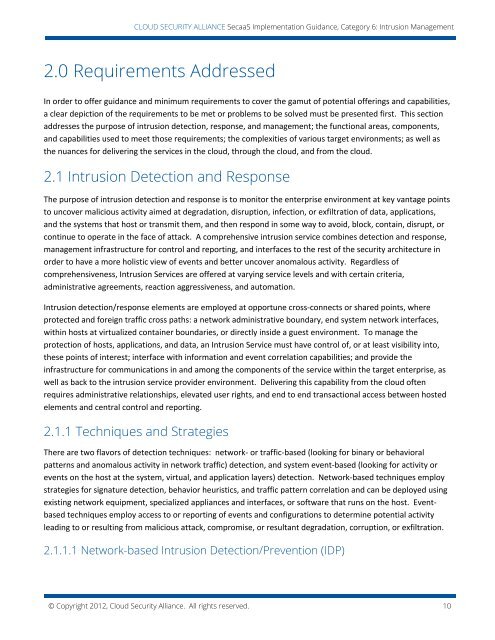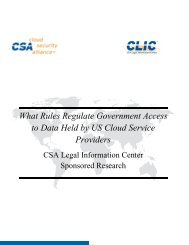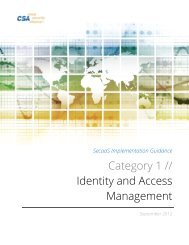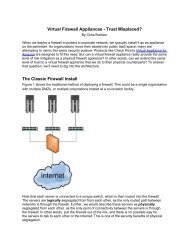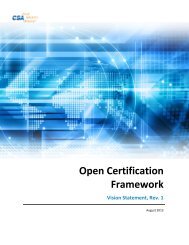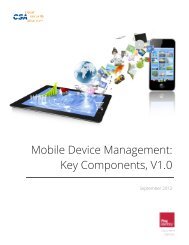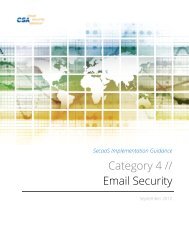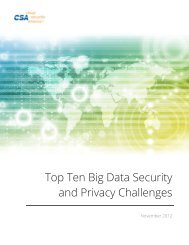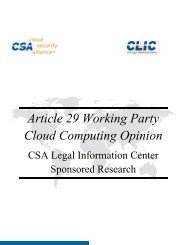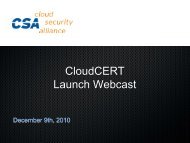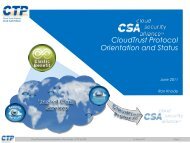Download - Cloud Security Alliance
Download - Cloud Security Alliance
Download - Cloud Security Alliance
- No tags were found...
You also want an ePaper? Increase the reach of your titles
YUMPU automatically turns print PDFs into web optimized ePapers that Google loves.
CLOUD SECURITY ALLIANCE SecaaS Implementation Guidance, Category 6: Intrusion Management2.0 Requirements AddressedIn order to offer guidance and minimum requirements to cover the gamut of potential offerings and capabilities,a clear depiction of the requirements to be met or problems to be solved must be presented first. This sectionaddresses the purpose of intrusion detection, response, and management; the functional areas, components,and capabilities used to meet those requirements; the complexities of various target environments; as well asthe nuances for delivering the services in the cloud, through the cloud, and from the cloud.2.1 Intrusion Detection and ResponseThe purpose of intrusion detection and response is to monitor the enterprise environment at key vantage pointsto uncover malicious activity aimed at degradation, disruption, infection, or exfiltration of data, applications,and the systems that host or transmit them, and then respond in some way to avoid, block, contain, disrupt, orcontinue to operate in the face of attack. A comprehensive intrusion service combines detection and response,management infrastructure for control and reporting, and interfaces to the rest of the security architecture inorder to have a more holistic view of events and better uncover anomalous activity. Regardless ofcomprehensiveness, Intrusion Services are offered at varying service levels and with certain criteria,administrative agreements, reaction aggressiveness, and automation.Intrusion detection/response elements are employed at opportune cross-connects or shared points, whereprotected and foreign traffic cross paths: a network administrative boundary, end system network interfaces,within hosts at virtualized container boundaries, or directly inside a guest environment. To manage theprotection of hosts, applications, and data, an Intrusion Service must have control of, or at least visibility into,these points of interest; interface with information and event correlation capabilities; and provide theinfrastructure for communications in and among the components of the service within the target enterprise, aswell as back to the intrusion service provider environment. Delivering this capability from the cloud oftenrequires administrative relationships, elevated user rights, and end to end transactional access between hostedelements and central control and reporting.2.1.1 Techniques and StrategiesThere are two flavors of detection techniques: network- or traffic-based (looking for binary or behavioralpatterns and anomalous activity in network traffic) detection, and system event-based (looking for activity orevents on the host at the system, virtual, and application layers) detection. Network-based techniques employstrategies for signature detection, behavior heuristics, and traffic pattern correlation and can be deployed usingexisting network equipment, specialized appliances and interfaces, or software that runs on the host. Eventbasedtechniques employ access to or reporting of events and configurations to determine potential activityleading to or resulting from malicious attack, compromise, or resultant degradation, corruption, or exfiltration.2.1.1.1 Network-based Intrusion Detection/Prevention (IDP)© Copyright 2012, <strong>Cloud</strong> <strong>Security</strong> <strong>Alliance</strong>. All rights reserved. 10


